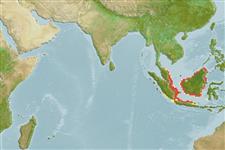>
Clupeiformes (Herrings) >
Dorosomatidae (Gizzard shads and sardinellas)
Etymology: Tenualosa: Latin, tenuis = thin + Latin, alausa = a fish cited by Ausonius and Latin, halec = pickle, dealing with the Greek word hals = salt; it is also the old Saxon name for shad = "alli" ; 1591 (Ref. 45335).
More on author: Bleeker.
Environment: milieu / climate zone / depth range / distribution range
Écologie
marin; eau douce; saumâtre; anadrome (Ref. 51243); profondeur 0 - 50 m (Ref. 188). Tropical; 7°N - 9°S, 101°E - 119°E (Ref. 188)
Western Central Pacific: Malaysia, Indonesia (Java Sea and Sarawak, also affluent rivers) and Thailand (southern tip).
Taille / Poids / Âge
Maturity: Lm ? range ? - ? cm
Max length : 52.0 cm SL mâle / non sexé; (Ref. 188)
Épines dorsales (Total): 0; Épines anales 0. Body moderately deep, belly with 30 to 31 scutes. A median notch on upper jaw distinguishes it from other similar clupeids, except Hilsa kelee. Gill rakers fine but not numerous. Caudal fin long, the lobes long and pointed. No series of dark spots along flank. Resembles T. toli, which has longer head but shorter tail; T. reevesii has many more lower gill rakers and a larger head.
Schooling in coastal waters and ascending rivers to breed. Feeds on zooplankton (Ref. 58784). Presumably its biology is similar to that of T. ilisha, but the fewer gillrakers suggest that it takes larger food organisms. A protandrous hermaphrodite (Ref. 55367).
Life cycle and mating behavior
Maturité | Reproduction | Frai | Œufs | Fécondité | Larves
A monandric species (Ref. 55367). Sex change occurs at a length of 19.0 cm TL and 0.9 year of age (Ref. 55367).
Whitehead, P.J.P., 1985. FAO Species Catalogue. Vol. 7. Clupeoid fishes of the world (suborder Clupeoidei). An annotated and illustrated catalogue of the herrings, sardines, pilchards, sprats, shads, anchovies and wolf-herrings. FAO Fish. Synop. 125(7/1):1-303. Rome: FAO. (Ref. 188)
Statut dans la liste rouge de l'IUCN (Ref. 130435)
Menace pour l'homme
Harmless
Utilisations par l'homme
Pêcheries: commercial
Plus d'informations
RéférencesAquacultureProfil d'aquacultureSouchesGénétiqueElectrophoresesHéritabilitéPathologiesTraitementNutrientsMass conversion
CollaborateursImagesStamps, Coins Misc.SonsCiguateraVitesseType de nageSurface branchialeOtolithesCerveauxVision
Outils
Articles particuliers
Télécharger en XML
Sources Internet
Estimates based on models
Preferred temperature (Ref.
123201): 28.2 - 29.1, mean 28.8 °C (based on 266 cells).
Phylogenetic diversity index (Ref.
82804): PD
50 = 0.5312 [Uniqueness, from 0.5 = low to 2.0 = high].
Bayesian length-weight: a=0.00912 (0.00433 - 0.01920), b=3.04 (2.87 - 3.21), in cm total length, based on LWR estimates for this (Sub)family-body shape (Ref.
93245).
Niveau trophique (Ref.
69278): 2.7 ±0.1 se; based on size and trophs of closest relatives
Résilience (Ref.
120179): Haut, temps minimum de doublement de population inférieur à 15 mois (Assuming fec >10,000).
Fishing Vulnerability (Ref.
59153): Moderate to high vulnerability (45 of 100).
Nutrients (Ref.
124155): Calcium = 90 [66, 133] mg/100g; Iron = 2.46 [1.40, 4.15] mg/100g; Protein = 17.3 [16.5, 18.2] %; Omega3 = 0.586 [0.280, 1.275] g/100g; Selenium = 45.7 [18.3, 113.8] μg/100g; VitaminA = 14.1 [4.7, 42.9] μg/100g; Zinc = 1.11 [0.70, 1.89] mg/100g (wet weight); based on
nutrient studies.
